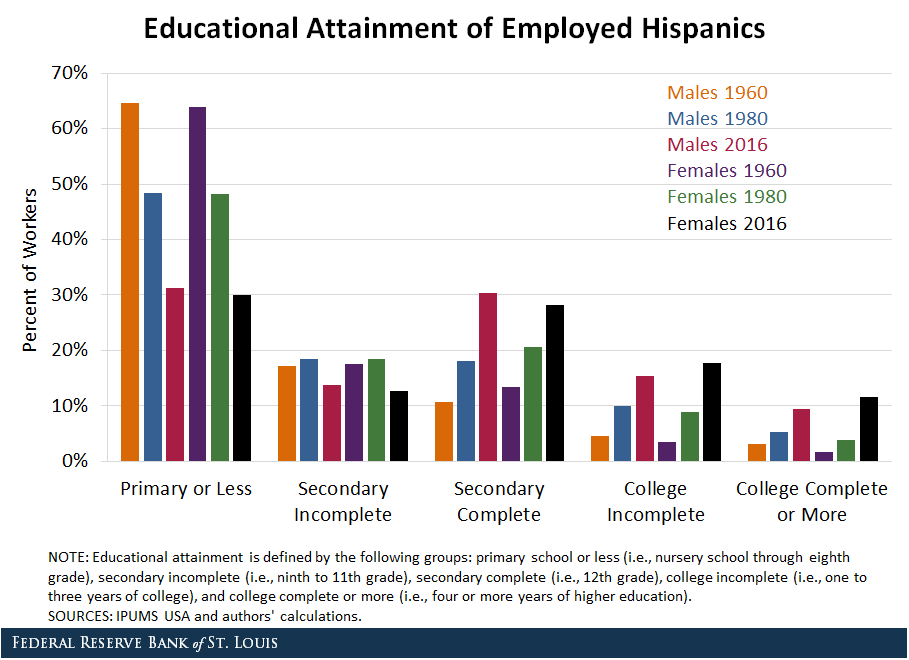U.S. Hispanic Workers: Education and Occupation Differ by Gender

In the U.S., female Hispanic workers surpass their male counterparts in education and in higher-paying jobs, according to a recent Regional Economist article.
“In particular, Hispanic women with college education substantially outnumber their male counterparts. Much more dramatic, the share of Hispanic female workers in professional occupations almost doubles that of their male counterparts,” wrote Alexander Monge-Naranjo, a research officer and economist, and Juan Ignacio Vizcaino, a former technical research associate.
Using the IPUMS USA data set, the authors examined changes in educational attainment of male and female Hispanic workers from 1960 to 2016. They also looked at changes in Hispanic workers’ occupations over this period.
Education
They first compared changes in educational attainment of employed Hispanics, shown in the figure below.

For the two highest education levels, female Hispanic workers have advanced at a faster pace. The authors found that the share of male Hispanic workers with incomplete college increased from 4 percent in 1960 to 15 percent in 2016, while the share of female Hispanic workers with incomplete college rose from 3 percent to 18 percent.
Similarly, they found that the share of male Hispanic workers with complete college or more rose from 3 percent to 9 percent over this period, while the share rose from 2 percent to 12 percent among female Hispanic workers.
“One simple way to summarize the difference as of 2016 is to say that the women-to-men ratio of Hispanic workers with university degrees is 4-to-3,” the authors said.
Occupations
To compare changes in occupations from 1960 to 2016, the authors looked at nine broad occupational groups, ordered by their skill intensity:
- Professional and technical workers
- Managers, officials and proprietors
- Sales workers
- Clerical and kindred
- Craftsmen
- Service workers
- Operatives
- Farmers and farm laborers
- Unskilled laborers
The authors noted that in two higher-paid occupation groups (professionals and managers), the share of male and female Hispanic workers has increased.
Among all male Hispanic workers, the percentage who were managers roughly doubled since 1960, the authors noted. For female Hispanic workers, the percentage who were managers roughly quadrupled, although this percentage remains slightly lower than the equivalent one for men.
“While the gender gap in managerial positions has almost closed, the most remarkable difference is with respect to professional positions, in which women have clearly dominated men,” the authors said.
Among all female Hispanic workers in 2016, the authors found that the percentage who were in professional occupations was 19.1 percent—almost twice as high as the percentage for Hispanic men (10.6 percent).
“All in all, women are the ones pushing forward the advancement of Hispanic workers in the education and occupation ladders in the U.S. marketplace,” they wrote.
Additional Resources
- Regional Economist: In the U.S. Hispanic Labor Force, Women Surpass Men in Multiple Ways
- Regional Economist: Hispanics and Their Contribution to America’s Human Capital
- On the Economy: U.S. Workers Face Tougher Competition from Abroad
Citation
ldquoU.S. Hispanic Workers: Education and Occupation Differ by Gender,rdquo St. Louis Fed On the Economy, Nov. 29, 2018.
This blog offers commentary, analysis and data from our economists and experts. Views expressed are not necessarily those of the St. Louis Fed or Federal Reserve System.
Email Us
All other blog-related questions

